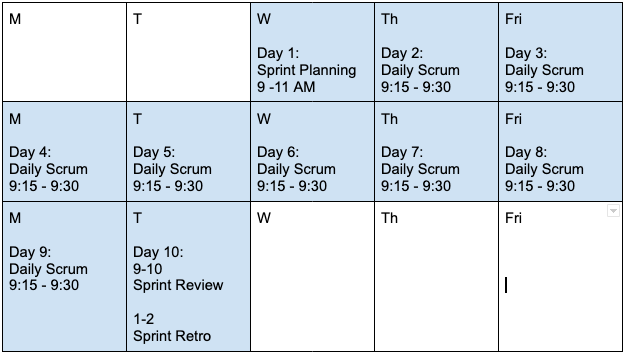
Getting started with Scrum doesn’t need to be a laborious process, but there are a few things you want to settle with your team before you take off sprinting. Teams that are organized around outcomes, have the right people on the team to deliver valuable work, can commit to a common cadence and have a shared definition of done will be positioned to be a high-performing team.
Organize Teams Around Outcomes
Great Scrum teams have a shared purpose and can deliver outcomes that add value to customers, rather than outputting a bunch of unrelated tasks.
You’ll want to make sure the entire team understands their mission for being a team, what success looks like and what outcomes they plan to achieve.
Let’s say you work on a website for an athletic shoe company. It’s a huge company, but your team has a clear shared purpose that is customer-facing—to maintain all of the web pages related to basketball shoes. It doesn’t matter if you’re a frontend or backend developer—your mission is to provide a great customer experience on your website for customers interested in purchasing basketball shoes.
And keep in mind your team’s goal isn’t to produce as many pages on the site as you can—that would be output focused. Your goal is only to focus on your mission of basketball shoe pages, but to deliver updates that your customers really want.
Have the Right People on the Team
Having the right people on the team to deliver work from start to finish is a critical, but important mission for a good Scrum team. If you come from an organization where people are very specialized in their skills, it may take some time, but cross-training is necessary so that the team can work like a small start-up, from planning to execution without having to rely on other teams.
When forming teams, think about all of the skills needed for the mission. For the website team, they may need a designer, developer, tester, marketer and a writer. Since Scrum teams are small, the writer may have to edit, the developer may have to do some lightweight design and the marketer may have to do some writing. They are able to work together to get the job done and delivered in a timely manner.
Agree on a Cadence
Once you have the team’s outcome-oriented mission and you’ve chosen team members that can accomplish the mission, it’s time for the team to meet and agree on a working cadence. A cadence is a way to establish a rhythm for Scrum events so that the team can spend minimal time in meetings and discussing when to meet, while maximizing the time they have to get real work done.
A lot of teams choose to avoid Mondays and Fridays because they often interfere with holidays and vacations, but do what works best for your team.
A pretty common cadence for a two-week sprint looks something like this:


Make sure to agree on the cadence with all team members, noting any people who have regular conflicts. While you can’t always please everyone, try to accommodate team members so you can get a commitment that they will attend all of the Scrum events. Having the entire team present is important for building collaboration, trust and efficiency.
Create Your Team’s Definition of Done
With all team members present, discuss what done work looks like to everyone. Having a common understanding of done will help your team from spinning aimlessly at the end of the sprint wondering if they can call a story done before or after regression testing.
The Definition of Done is an important piece of the Scrum framework, but it should evolve over time as your team becomes more agile.
When starting out, make sure ‘done’ is something that your team can control themselves. If they are always relying on, say, Legal to sign off, but Legal isn’t on the team, they may get frustrated that they can never get anything done. Done should be the highest level of quality your team can meet given the current situation.
Some common Definitions of Done for a software development team are:
Code is peer reviewed
Code is tested and integrated (to some environment other than local)
No known defects
Product Owner approval that acceptance criteria are met
With these things in mind, you’re going to be off and sprinting in no time, while delivering high-value products and services to your customers.
We talk more about this in our Certified ScrumMaster® Workshops, we would love to have you!